window BUICK LUCERNE 2006 Owner's Guide
[x] Cancel search | Manufacturer: BUICK, Model Year: 2006, Model line: LUCERNE, Model: BUICK LUCERNE 2006Pages: 416, PDF Size: 2.6 MB
Page 270 of 416
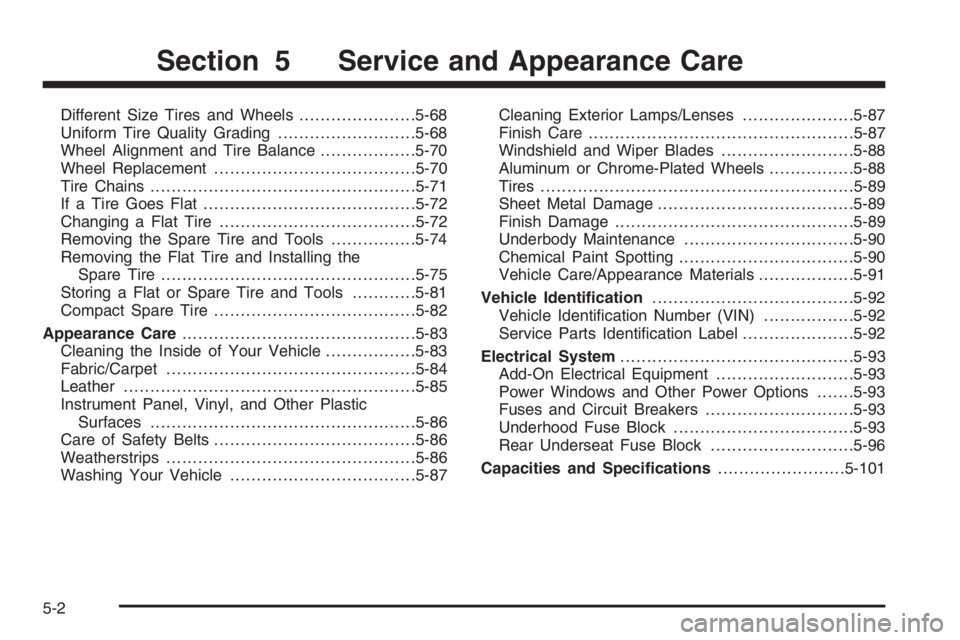
Different Size Tires and Wheels......................5-68
Uniform Tire Quality Grading..........................5-68
Wheel Alignment and Tire Balance..................5-70
Wheel Replacement......................................5-70
Tire Chains..................................................5-71
If a Tire Goes Flat........................................5-72
Changing a Flat Tire.....................................5-72
Removing the Spare Tire and Tools................5-74
Removing the Flat Tire and Installing the
Spare Tire................................................5-75
Storing a Flat or Spare Tire and Tools............5-81
Compact Spare Tire......................................5-82
Appearance Care............................................5-83
Cleaning the Inside of Your Vehicle.................5-83
Fabric/Carpet...............................................5-84
Leather.......................................................5-85
Instrument Panel, Vinyl, and Other Plastic
Surfaces..................................................5-86
Care of Safety Belts......................................5-86
Weatherstrips...............................................5-86
Washing Your Vehicle...................................5-87Cleaning Exterior Lamps/Lenses.....................5-87
Finish Care..................................................5-87
Windshield and Wiper Blades.........................5-88
Aluminum or Chrome-Plated Wheels................5-88
Tires...........................................................5-89
Sheet Metal Damage.....................................5-89
Finish Damage.............................................5-89
Underbody Maintenance................................5-90
Chemical Paint Spotting.................................5-90
Vehicle Care/Appearance Materials..................5-91
Vehicle Identi�cation......................................5-92
Vehicle Identi�cation Number (VIN).................5-92
Service Parts Identi�cation Label.....................5-92
Electrical System............................................5-93
Add-On Electrical Equipment..........................5-93
Power Windows and Other Power Options.......5-93
Fuses and Circuit Breakers............................5-93
Underhood Fuse Block..................................5-93
Rear Underseat Fuse Block...........................5-96
Capacities and Speci�cations........................5-101
Section 5 Service and Appearance Care
5-2
Page 296 of 416

If No Steam Is Coming From Your
Engine
If you get an engine overheat warning but see or hear
no steam, the problem may not be too serious.
Sometimes the engine can get a little too hot when you:
Climb a long hill on a hot day.
Stop after high-speed driving.
Idle for long periods in traffic.
Tow a trailer.
If you get the overheat warning with no sign of steam,
try this for a minute or so:
1. In heavy traffic, let the engine idle in NEUTRAL (N)
while stopped. If it is safe to do so, pull off the road,
shift to PARK (P) or NEUTRAL (N) and let the
engine idle.
2. Turn on your heater to full hot at the highest fan
speed and open the windows as necessary.
If you no longer have the overheat warning, you can
drive. Just to be safe, drive slower for about 10 minutes.
If the warning does not come back on, you can drive
normally.
If the warning continues and you have not stopped, pull
over, stop, and park your vehicle right away.If there is still no sign of steam, you can idle the engine
for three minutes while you are parked. If you still
have the warning,turn off the engine and get everyone
out of the vehicleuntil it cools down.
You may decide not to lift the hood but to get service
help right away.
Overheated Engine Protection
Operating Mode
(4.6L V8 Engine Only)
If an overheated engine condition exists and the
message ENGINE OVERHEATED STOP ENGINE is
displayed, an overheat protection mode which alternates
�ring groups of cylinders helps prevent engine damage.
In this mode, you will notice a loss in power and
engine performance. This operating mode allows your
vehicle to be driven to a safe place in an emergency.
Driving extended miles (km) and/or towing a trailer in the
overheat protection mode should be avoided.
Notice:After driving in the overheated engine
protection operating mode, to avoid engine damage,
allow the engine to cool before attempting any
repair. The engine oil will be severely degraded.
Repair the cause of coolant loss, change the oil and
reset the oil life system. SeeEngine Oil on
page 5-15.
5-28
Page 327 of 416
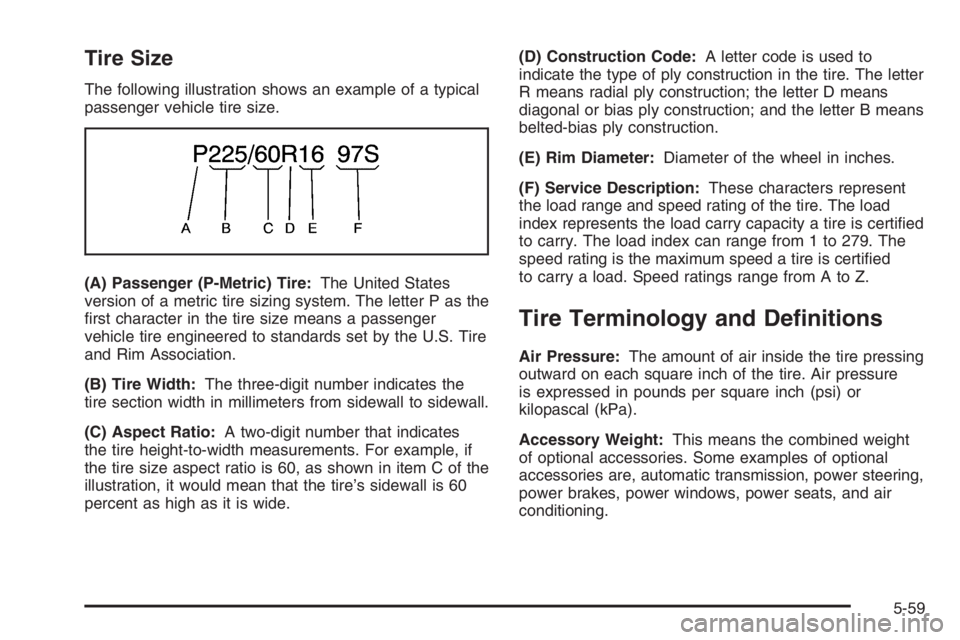
Tire Size
The following illustration shows an example of a typical
passenger vehicle tire size.
(A) Passenger (P-Metric) Tire:The United States
version of a metric tire sizing system. The letter P as the
�rst character in the tire size means a passenger
vehicle tire engineered to standards set by the U.S. Tire
and Rim Association.
(B) Tire Width:The three-digit number indicates the
tire section width in millimeters from sidewall to sidewall.
(C) Aspect Ratio:A two-digit number that indicates
the tire height-to-width measurements. For example, if
the tire size aspect ratio is 60, as shown in item C of the
illustration, it would mean that the tire’s sidewall is 60
percent as high as it is wide.(D) Construction Code:A letter code is used to
indicate the type of ply construction in the tire. The letter
R means radial ply construction; the letter D means
diagonal or bias ply construction; and the letter B means
belted-bias ply construction.
(E) Rim Diameter:Diameter of the wheel in inches.
(F) Service Description:These characters represent
the load range and speed rating of the tire. The load
index represents the load carry capacity a tire is certi�ed
to carry. The load index can range from 1 to 279. The
speed rating is the maximum speed a tire is certi�ed
to carry a load. Speed ratings range from A to Z.
Tire Terminology and De�nitions
Air Pressure:The amount of air inside the tire pressing
outward on each square inch of the tire. Air pressure
is expressed in pounds per square inch (psi) or
kilopascal (kPa).
Accessory Weight:This means the combined weight
of optional accessories. Some examples of optional
accessories are, automatic transmission, power steering,
power brakes, power windows, power seats, and air
conditioning.
5-59
Page 351 of 416
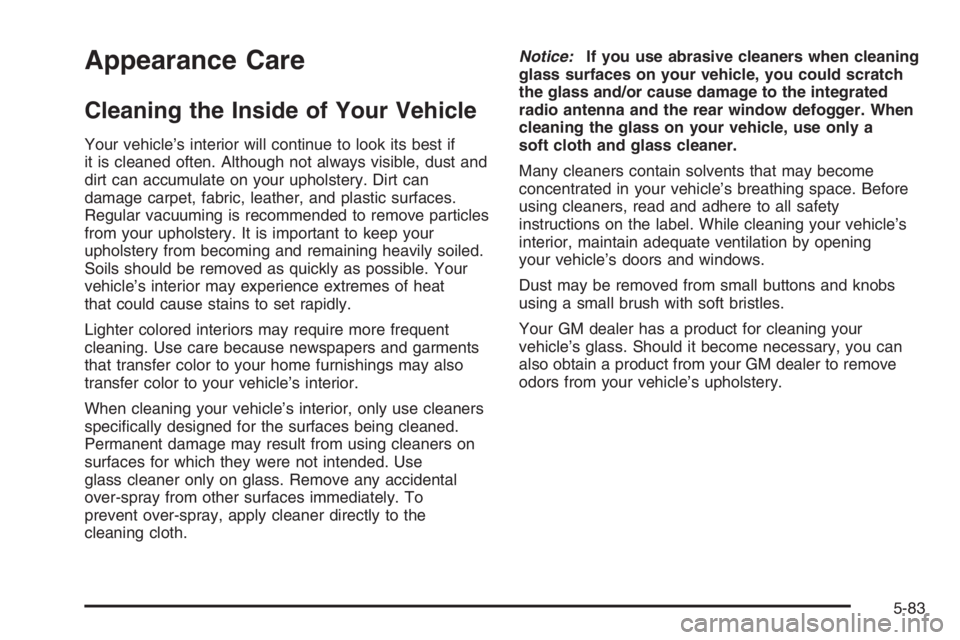
Appearance Care
Cleaning the Inside of Your Vehicle
Your vehicle’s interior will continue to look its best if
it is cleaned often. Although not always visible, dust and
dirt can accumulate on your upholstery. Dirt can
damage carpet, fabric, leather, and plastic surfaces.
Regular vacuuming is recommended to remove particles
from your upholstery. It is important to keep your
upholstery from becoming and remaining heavily soiled.
Soils should be removed as quickly as possible. Your
vehicle’s interior may experience extremes of heat
that could cause stains to set rapidly.
Lighter colored interiors may require more frequent
cleaning. Use care because newspapers and garments
that transfer color to your home furnishings may also
transfer color to your vehicle’s interior.
When cleaning your vehicle’s interior, only use cleaners
speci�cally designed for the surfaces being cleaned.
Permanent damage may result from using cleaners on
surfaces for which they were not intended. Use
glass cleaner only on glass. Remove any accidental
over-spray from other surfaces immediately. To
prevent over-spray, apply cleaner directly to the
cleaning cloth.Notice:If you use abrasive cleaners when cleaning
glass surfaces on your vehicle, you could scratch
the glass and/or cause damage to the integrated
radio antenna and the rear window defogger. When
cleaning the glass on your vehicle, use only a
soft cloth and glass cleaner.
Many cleaners contain solvents that may become
concentrated in your vehicle’s breathing space. Before
using cleaners, read and adhere to all safety
instructions on the label. While cleaning your vehicle’s
interior, maintain adequate ventilation by opening
your vehicle’s doors and windows.
Dust may be removed from small buttons and knobs
using a small brush with soft bristles.
Your GM dealer has a product for cleaning your
vehicle’s glass. Should it become necessary, you can
also obtain a product from your GM dealer to remove
odors from your vehicle’s upholstery.
5-83
Page 361 of 416
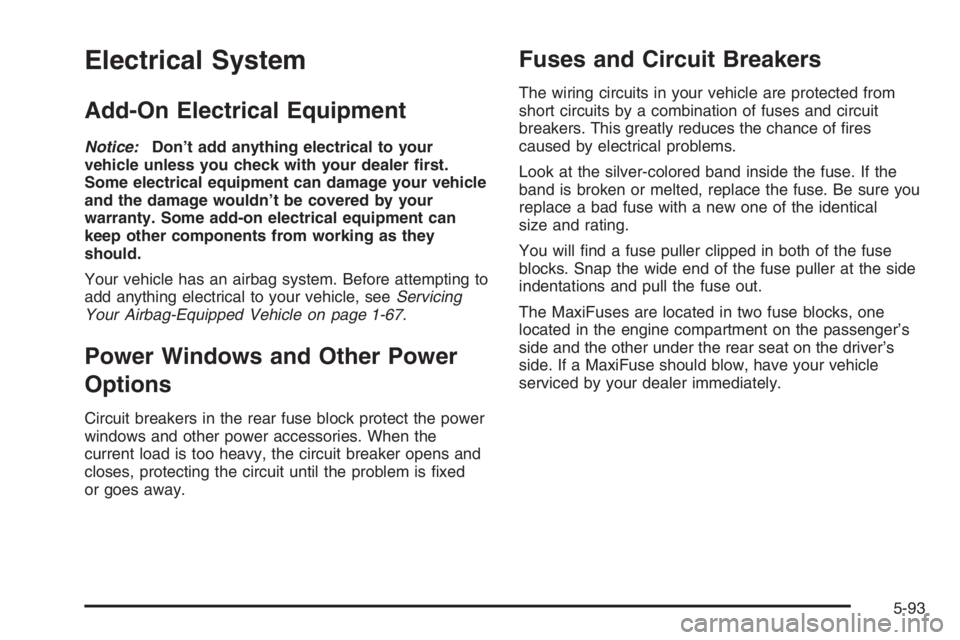
Electrical System
Add-On Electrical Equipment
Notice:Don’t add anything electrical to your
vehicle unless you check with your dealer �rst.
Some electrical equipment can damage your vehicle
and the damage wouldn’t be covered by your
warranty. Some add-on electrical equipment can
keep other components from working as they
should.
Your vehicle has an airbag system. Before attempting to
add anything electrical to your vehicle, seeServicing
Your Airbag-Equipped Vehicle on page 1-67.
Power Windows and Other Power
Options
Circuit breakers in the rear fuse block protect the power
windows and other power accessories. When the
current load is too heavy, the circuit breaker opens and
closes, protecting the circuit until the problem is �xed
or goes away.
Fuses and Circuit Breakers
The wiring circuits in your vehicle are protected from
short circuits by a combination of fuses and circuit
breakers. This greatly reduces the chance of �res
caused by electrical problems.
Look at the silver-colored band inside the fuse. If the
band is broken or melted, replace the fuse. Be sure you
replace a bad fuse with a new one of the identical
size and rating.
You will �nd a fuse puller clipped in both of the fuse
blocks. Snap the wide end of the fuse puller at the side
indentations and pull the fuse out.
The MaxiFuses are located in two fuse blocks, one
located in the engine compartment on the passenger’s
side and the other under the rear seat on the driver’s
side. If a MaxiFuse should blow, have your vehicle
serviced by your dealer immediately.
5-93
Page 368 of 416
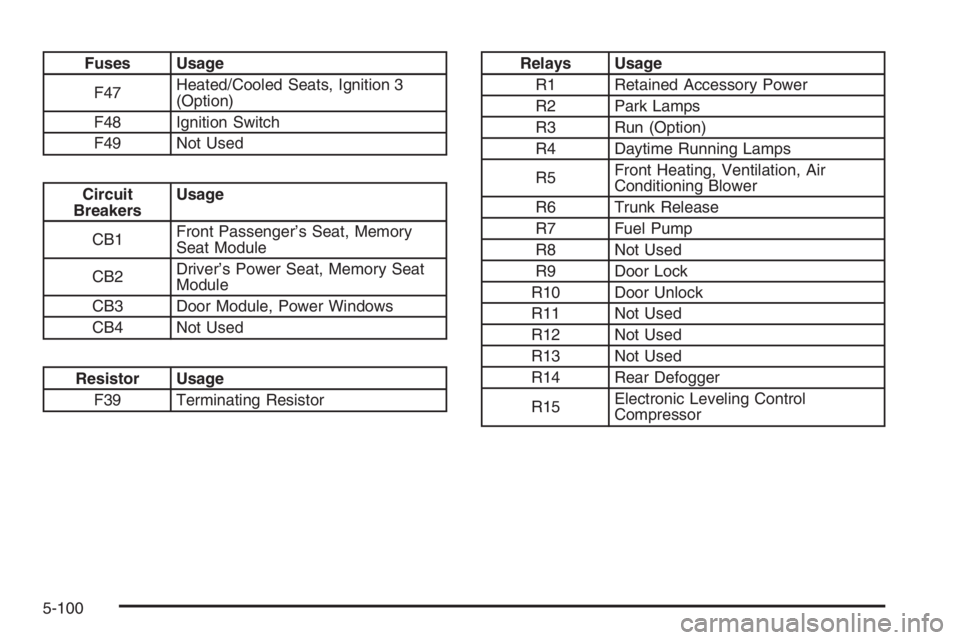
Fuses Usage
F47Heated/Cooled Seats, Ignition 3
(Option)
F48 Ignition Switch
F49 Not Used
Circuit
BreakersUsage
CB1Front Passenger’s Seat, Memory
Seat Module
CB2Driver’s Power Seat, Memory Seat
Module
CB3 Door Module, Power Windows
CB4 Not Used
Resistor Usage
F39 Terminating Resistor
Relays Usage
R1 Retained Accessory Power
R2 Park Lamps
R3 Run (Option)
R4 Daytime Running Lamps
R5Front Heating, Ventilation, Air
Conditioning Blower
R6 Trunk Release
R7 Fuel Pump
R8 Not Used
R9 Door Lock
R10 Door Unlock
R11 Not Used
R12 Not Used
R13 Not Used
R14 Rear Defogger
R15Electronic Leveling Control
Compressor
5-100
Page 407 of 416

E
Electrical System
Add-On Equipment......................................5-93
Fuses and Circuit Breakers...........................5-93
Power Windows and Other Power Options......5-93
Rear Underseat Fuse Block..........................5-96
Underhood Fuse Block.................................5-94
Engine
Air Cleaner/Filter.........................................5-19
Battery.......................................................5-42
Check and Service Engine Soon Light............3-44
Coolant......................................................5-23
Coolant Heater............................................2-24
Coolant Temperature Gage...........................3-43
Coolant Temperature Warning Light................3-43
Engine Compartment Overview......................5-12
Exhaust.....................................................2-31
Oil .............................................................5-15
Oil Life System...........................................5-18
Overheated Protection Operating Mode...........5-28
Overheating................................................5-27
Starting......................................................2-23
Entry Lighting.................................................3-17
Event Data Recorders (EDR)............................. 7-9
Extender, Safety Belt.......................................1-30
Exterior Lamps...............................................3-14
Exterior Lighting Battery Saver..........................3-16
F
Filter
Engine Air Cleaner......................................5-19
Finish Damage...............................................5-89
Flashers, Hazard Warning.................................. 3-6
Flash-to-Pass................................................... 3-8
Flat Tire........................................................5-72
Flat Tire, Changing.........................................5-72
Flat Tire, Storing.............................................5-81
Fluid
Automatic Transaxle.....................................5-21
Power Steering...........................................5-38
Windshield Washer......................................5-39
Fog Lamp Light..............................................3-48
Fog Lamps ....................................................3-16
Front Reading Lamps......................................3-18
Front Storage Area.........................................2-44
Fuel............................................................... 5-5
Additives...................................................... 5-6
California Fuel.............................................. 5-6
Filling a Portable Fuel Container....................5-10
Filling Your Tank........................................... 5-8
Fuels in Foreign Countries.............................. 5-7
Gage .........................................................3-49
Gasoline Octane........................................... 5-5
Gasoline Speci�cations.................................. 5-5
5
Page 412 of 416
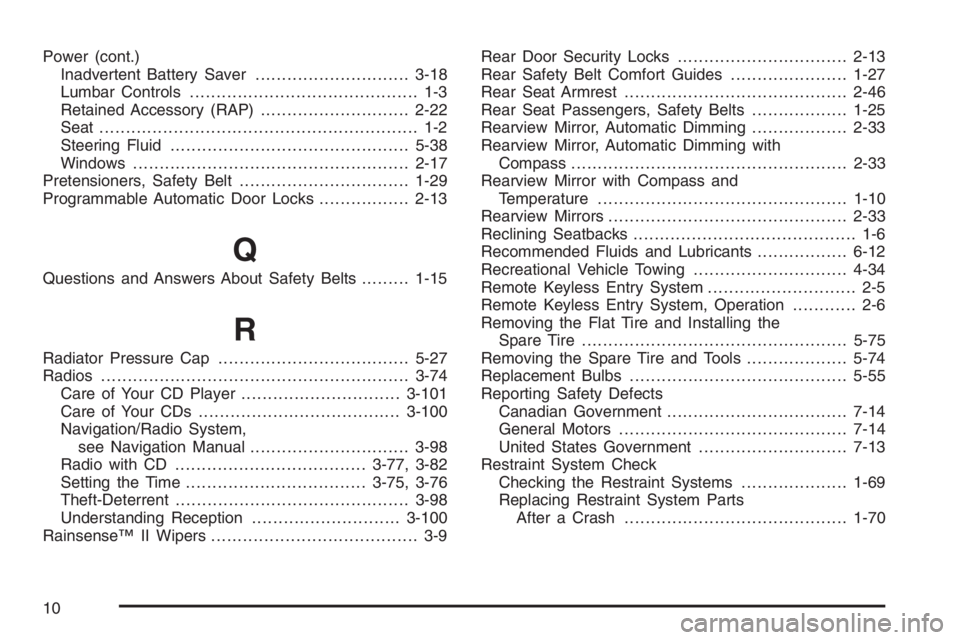
Power (cont.)
Inadvertent Battery Saver.............................3-18
Lumbar Controls........................................... 1-3
Retained Accessory (RAP)............................2-22
Seat ............................................................ 1-2
Steering Fluid.............................................5-38
Windows....................................................2-17
Pretensioners, Safety Belt................................1-29
Programmable Automatic Door Locks.................2-13
Q
Questions and Answers About Safety Belts.........1-15
R
Radiator Pressure Cap....................................5-27
Radios..........................................................3-74
Care of Your CD Player..............................3-101
Care of Your CDs ......................................3-100
Navigation/Radio System,
see Navigation Manual..............................3-98
Radio with CD....................................3-77, 3-82
Setting the Time..................................3-75, 3-76
Theft-Deterrent............................................3-98
Understanding Reception............................3-100
Rainsense™ II Wipers....................................... 3-9Rear Door Security Locks................................2-13
Rear Safety Belt Comfort Guides......................1-27
Rear Seat Armrest..........................................2-46
Rear Seat Passengers, Safety Belts..................1-25
Rearview Mirror, Automatic Dimming..................2-33
Rearview Mirror, Automatic Dimming with
Compass....................................................2-33
Rearview Mirror with Compass and
Temperature...............................................1-10
Rearview Mirrors.............................................2-33
Reclining Seatbacks.......................................... 1-6
Recommended Fluids and Lubricants.................6-12
Recreational Vehicle Towing.............................4-34
Remote Keyless Entry System............................ 2-5
Remote Keyless Entry System, Operation............ 2-6
Removing the Flat Tire and Installing the
Spare Tire..................................................5-75
Removing the Spare Tire and Tools...................5-74
Replacement Bulbs.........................................5-55
Reporting Safety Defects
Canadian Government..................................7-14
General Motors...........................................7-14
United States Government............................7-13
Restraint System Check
Checking the Restraint Systems....................1-69
Replacing Restraint System Parts
After a Crash..........................................1-70
10
Page 416 of 416

W
Warning Lights, Gages and Indicators................3-33
Warnings
DIC Warnings and Messages........................3-56
Hazard Warning Flashers............................... 3-6
Other Warning Devices.................................. 3-6
Safety and Symbols......................................... iii
Vehicle Damage.............................................. iv
Wheels
Alignment and Tire Balance..........................5-70
Different Size..............................................5-68
Replacement...............................................5-70
Where to Put the Restraint...............................1-40
Windows.......................................................2-16
Power ........................................................2-17Windshield
Rainsense™ II Wipers................................... 3-9
Washer......................................................3-10
Washer Fluid..............................................5-39
Wiper Blade Replacement.............................5-55
Wiper Blades, Cleaning................................5-88
Wipers......................................................... 3-8
Winter Driving................................................4-24
Wiper Activated Headlamps..............................3-15
X
XM™ Satellite Radio Antenna System..............3-101
Y
Your Vehicle and the Environment....................... 6-2
14